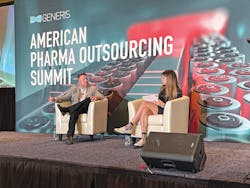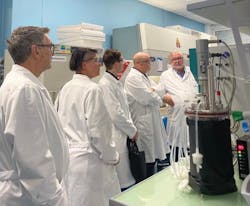As the world works to heal from a pandemic that is still ongoing, the pharma industry's appetite for travel and in-person events appears to have returned.
CPHI Worldwide
Last month, the Pharma Manufacturing editorial staff packed our bags and headed to Frankfurt for pharma’s go-to event. Held November 1-3 at the massive Festhalle Messe Frankfurt (over 4 million square feet!), the biggest international trade event in pharma did not disappoint.
Trends on the show floor were not necessarily new, but instead reinforced important existing drives in the industry. Here’s what you missed:
The green thumbs up
This year marked the debut of a dedicated Sustainability Theatre which played host to 15 dedicated sessions on manufacturing sustainability. But the green was not confined to the theater — it seemingly permeated all of the halls at CPHI.
While sustainability is definitely not a new topic — and no industry is immune to greenwashing— this time, it felt different.
“Until recently, there was no legislative drive for sustainability, but now EU directives are really pushing it,” said Michiel van den Berg, director of Global Pharmaceutical Packaging Development at Tekni-Plex.
Brian Scanlan, operating partner in Life Sciences, Edgewater Capital, echoed that sentiment, pointing out that “drugmakers are now looking for practical approaches to integrate ESG [environmental, social and corporate governance] on the plant floor.”
At the forefront of the sustainability push have been pharma packaging suppliers. The European Commission adopted the EU Plastics Strategy in January 2018, which, among other things, established the goal that all plastic packaging on the EU market must be recyclable by 2030. By ‘recyclable’ the strategy implies that some percentage of all plastic packaging must be recyclable. Currently, per the Packaging and Packaging Waste Directive, at least 65% by weight of all packaging waste must be recycled by the end of 2025.
The push goes beyond packaging. This year’s CPHI Sustainability Sentiment Index reported that 83% of those surveyed believe specific ‘sustainability metrics’ (full waste recycling, green power percentage, green chemistries, etc.) will be implemented within all CDMO contracts within the next five years.
All told, the message is that the industry must accelerate its drive towards greener manufacturing — and this has implications for all players in the pharma supply chain.
Solving solubility woes
Drug solubility is another long-standing issue for the pharma industry that is becoming even more pervasive. Today it is estimated that up to 90% of drugs in development are poorly soluble. Low drug solubility can limit the maximum drug concentration in the small intestine and, therefore, drug absorption.
The issue is bubbling to the forefront again because as more companies develop advanced therapeutics, they are facing greater drug solubility challenges. “Advanced therapeutics require advanced drug delivery systems,” said Scanlan.
The focus now is on developing technologies that can enhance these compounds’ absorption, making new drugs more bioavailable. In particular, the industry is turning to biodegradable and bioabsorbable polymers and lipid-based nanocarriers to introduce therapeutic substances into the body, said Scanlan.
CDMO trends
‘The great divide’: Edgewater Capital reports that in the U.S., mid-sized (~100-1000 employees) CDMOs are being bought up by larger CDMOs. There is a fragmented pool of about 1,500 small CDMOs who either stay small by design or grow to become consolidation targets.
This pattern has created a large divide in the contract manufacturing sector between the small players and the big ones.
Flexibility is key: According to BioVectra’s chief commercial officer, Heather Delage, “The decision-making matrix for pharma manufacturers has gotten increasingly complex.” As needs and priorities change, pharma manufacturers require CDMOs to be more flexible in scheduling and slot reservation timelines.
Executives at KBI Biopharma echoed this need for flexibility, emphasizing that CDMOs need to be able to accommodate last minute surge in demands from drugmakers. According to KBI, it’s imperative that CDMOs are nimble enough to build in capacity for these sudden spikes in demand.
Supply chain pressures trickle down
As supply chain issues persist, drugmakers are looking for redundancy in their suppliers. Having several ‘backup’ suppliers for everything from raw materials to packaging has become the norm.
According to Gearoid O’Rourke, vice president of Global Marketing for Actylis, material suppliers are facing more scrutiny from finished drug manufacturers. Drugmakers are expecting suppliers to have full control over their own supply chains and provide full transparency to their clients.
Actylis was recently created through the merger of eight specialty manufacturing companies and three sourcing firms. “We have a network of manufacturing facilities globally as well as over a thousand suppliers, so we can offer our customers both agility and choice,” said O’Rourke.
CDMOs are also facing the same pressures from drugmakers, according to Jim Donovan, Operations Lead, Pfizer CentreOne. In preparation for drug launches, pharma companies are turning to CDMOs, seeking backup manufacturing capacity. They are also inquiring with CDMOs to confirm they have backup suppliers for everything from APIs to packaging.
Driving down costs in CGT
Approved cell and gene therapies in the U.S. come with exorbitant price tags — in some cases over $2 million. Typically one-off, lifesaving treatments, their therapeutic effectiveness has made their high prices somewhat more palatable.
But juggling this tremendous cost of goods in manufacturing has been feasible only because the drugs have been produced for niche groups of patients, in small batches. But as more CGTs target broader indications and thus, more patients, how will companies manufacture them on a commercial scale and still keep prices affordable?
“Rare disease and orphan indications are not going to precipitate an existential cost of goods crisis for the cell and gene therapy field,” said Anthony Davies, chief executive officer and founder of Dark Horse Consulting. “But significant commercial approvals for large indications will…we are sleepwalking into a COGs crisis.”
Ultimately, manufacturing costs have the potential to stifle the promising cell and gene therapy sector.
“The good news is, COGs improvements are achievable in this field,” said Davies. “But investment needs to be made in the underlying analytical methods and process technologies.”
American Pharma Outsourcing Summit
The American Pharma Outsourcing Summit is a three-day event designed to provide pharma professionals with current trends, strategic insights and expertise in all things manufacturing. This year, the Pharma Manufacturing team was there and spoke to industry leaders about what has changed — and what has stayed the same.The evolution of outsourcing
Tom Holmes, chief technology operations officer at Amylyx, said that the biggest trend he’s seen change when it comes to CDMO selection is a shift in how people look at outsourcing. “Understanding that outsourcing is not just for a product coming out of a life cycle management situation and not transactional, but the evolution has been to create an atmosphere where your CDMO network is an extension of your company, is the biggest change I’ve seen in the last 25 years.”
What has not changed is the crucial role played by CDMOs.
“Outsourcing allows companies to explore disease-modifying opportunities without having to build a factory for every one of their products,” said Holmes. “It’s important to have the ability to find capabilities that are not your own because these CDMOs have been in place for decades and they have the experience of your product and an array of products, and why not leverage that capability?”
Quality goes big
According to Karin Ann Payne, vice president of Quality Assurance at Bayer, what was once a problem-solving department has become an enterprise leader in the manufacturing process. “Quality has evolved. We are now the group you come to when you have an idea — it's now a proactive practice.”
At the same time, Payne said, the expectation of quality has evolved.
“Now, regulatory agencies expect that you build quality into your product and that it does not end with manufacturing. It is moving toward an end with the customer,” said Payne. “It is a continuous process that does not end when manufacturing is completed.”
Measurable DEI efforts
Wanda Hope, chief diversity, equity, and inclusion officer at Johnson & Johnson spoke about the importance of holding pharma companies accountable to their diversity and inclusion commitments.
Hope emphasized that diversity and inclusion efforts need to be approached like other business goals — set and measured.
“We’ve all heard ‘what gets measured gets done,’ and at J&J, we take action with that mindset to try and find new ways to set, track and measure diversity and inclusion goals,” said Hope.
Hope stressed that only by starting with an evidence-based strategy can companies deliver measurable outcomes.
Lithuania Media Tour
Pharma Manufacturing’s Karen Langhauser had the chance this fall to journey across the world and see firsthand how the small but scrappy country of Lithuania has put itself on the life sciences map.The trip was sponsored by the recently launched Innovation Agency Lithuania which was established back in April by combining two nonprofit government agencies, Enterprise Lithuania and the Lithuanian Business Support Agency.
The Lithuanian government — armed with an ambitious goal to increase GDP contribution of the life sciences industry to 5% by 2030 — is hungry and eager to make sure the sector is successful.
Beyond life sciences, Lithuania is home to friendly people, delicious restaurants and even a filming location for “Stranger Things.” Check our website soon for a in-depth summary and discussion of opportunities offered by the newest Baltic hot spot.








